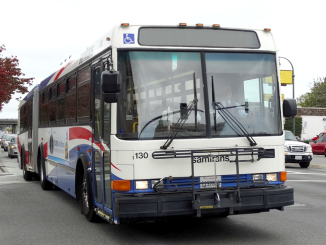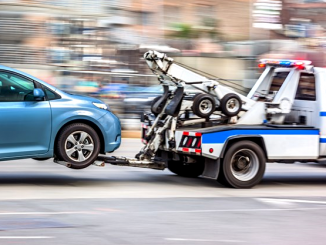
BY EMILY MIBACH
Daily Post Staff Writer
The “Get Us Moving” TV commercials have the look and feel of a campaign ad.
“Our county’s economy has been booming, and we need investment in our infrastructure and transit systems to keep pace,” a female announcer said in one commercial. “It’s time to get us moving again. New investment will ease traffic, fix potholes, help provide transportation for seniors and people with disabilities.”
The commercial juxtaposes pictures of crowded freeways, potholes and a senior citizen in a wheelchair being lifted onto a bus.
But it’s not a campaign ad. Get Us Moving is a $1 million effort to get public comment about what transportation priorities should be funded if San Mateo County voters approve a half-cent sales tax increase this November known as Measure W.
The $1 million came from tax funds. But under the law, once the tax hits the ballot, the government has to stop using tax dollars to promote it and a citizens committee will take over the job of persuading voters to raise their taxes.
Yesterday (July 11), the SamTrans board of directors unanimously approved putting the sales tax increase on the ballot. Now the attention will turn to the San Mateo County Board of Supervisors, which will vote later this month (July) on whether to put the tax on the ballot. Both boards must vote yes for it to go to the voters.
The Get Us Moving campaign spent part of the $1 million mailing survey cards to residents, asking for their opinions about how the $80 million from the tax would be used. About 14,000 of those cards were returned by residents, said Jeff Gee, a Redwood City councilman and SamTrans board member.
Charles Stone, a Belmont councilman and SamTrans board member, said the 14,000 cards represented an “unprecedented” amount of outreach.
Stone said the $80 million annual expenditure plan is better because of the outreach. He said the tax hike, if approved, would “disrupt traffic.”
Little money for grade separations
What’s striking about the plan is that only $2 million a year will go for “grade separations,” planner jargon for bridges above or below the Caltrain tracks. They’re important because as Caltrain increases the frequency of its trains, and high-speed trains are added to the tracks, crossings that are “at grade” (where the cars drive across the tracks) will be blocked several times an hour, backing up cars.
Cities along the Caltrain tracks are looking desperately for funds to build grade separations. And grade separations don’t come cheap.
Burlingame plans to spend $250 million on the Broadway grade separation, Menlo Park $190 million at Ravenswood Avenue, and San Mateo $180 million at 25th Avenue.
While only $2 million a year from the tax hike will go for grade separations, $40 million will go to Sam-Trans for its bus and paratransit services.
Another $18 million is earmarked for highway improvements.
The plan calls for $10 million for local streets, $8 million for “regional connection” projects such as reviving the Dumbarton rail line, and $4 million for bicycle and pedestrian improvements.
Tax-funded campaign ends soon
Once the Board of Supervisors votes to put the tax hike on the ballot, the Get Us Moving campaign is over, said SamTrans spokesman Dan Lieberman.
That means no more tax money can be spent on the campaign.
“Moving forward, the district can adopt a resolution supporting (or opposing) the ballot measure, and provide the public with impartial, factual information about what the measure’s effects would be. The (San Mateo County Transportation) district cannot and will not promote the measure or be involved in any political campaign,” Lieberman said.
Additionally, board members and employees can choose to get involved with the campaign, but only on their own time.
What about the people who gave their emails or phone numbers to the Get Us Moving campaign in the process of providing feedback on the spending list. Will that information be given out to either the for or against campaign?
“The district will not provide anyone with contact information obtained through the (Get Us Moving) process,” he said.
The new tax, if approved by two-thirds of voters in San Mateo County, will raise the county’s average tax rate from 8.75% to 9.25%. The average sales tax in the state is 7.25%.
With sales taxes, the state gets 6 pennies on the dollar and the rest of the tax is for city and county taxes. Normally, local governments can collect no more than 2 pennies on every retail sales dollar, and San Mateo County is pushing up against that limit.
But a bill by state Assemblyman Kevin Mullin, D-South San Francisco, that was signed into law by Gov. Jerry Brown in September, allows San Mateo County to add the half-cent sales tax and exceed the 2% cap.
Just how high San Mateo County residents are willing to raise their own taxes may be tested with this measure. Former Foster City Mayor Linda Koelling said it’s likely that a group will pop up against the tax.
“We’re so inundated with half-cent sales taxes here and the new bridge toll increases,” Koelling said, referring to the county-wide Measure K tax passed in 2016 to raise money for housing and other projects in the county. “How many taxes does it take to run a system?”
Koelling doesn’t dispute that there is a congestion problem in the county, but more investigation is needed to determine why the county’s traffic is as bad as it is. Koelling pointed to the increase of office complexes in the county, and the housing demand that is caused by the new offices.
“Why aren’t they (companies) building in other counties? There has to be a simpler fix rather than continuously taxing the people,” she said.



